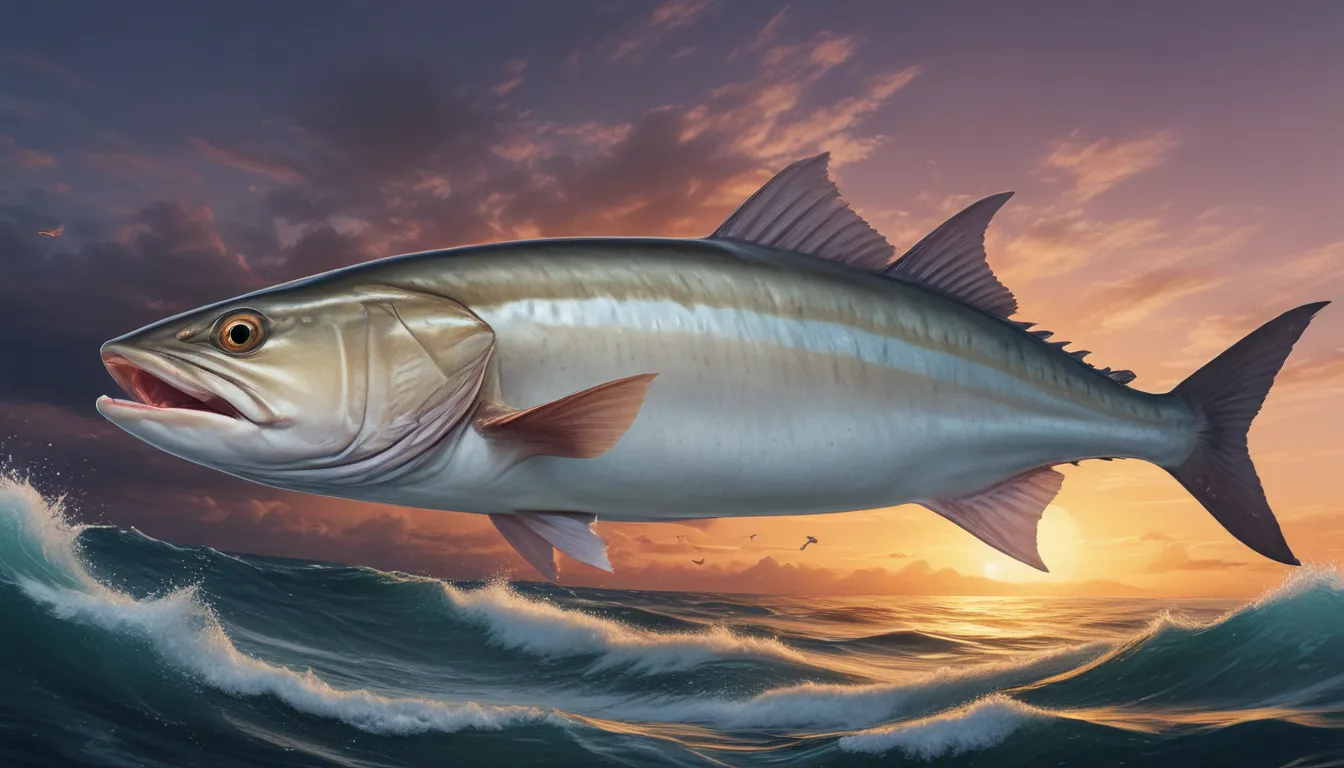The pictures we use in our articles might not show exactly what the words say. We choose these pictures to make you interested in reading more. The pictures work together with the words but don’t take their place. The words still tell you the important facts.
Welcome to the captivating world of amberjack, the "king of the reef" and a beloved species among anglers and seafood enthusiasts. Dive into the depths of the warm waters of the Atlantic Ocean to discover exciting facts about this remarkable fish that will expand your knowledge and captivate your interest. Whether you're a fishing enthusiast, a marine biology buff, or simply curious about the wonders of the ocean, the amberjack is sure to leave you in awe. Let's embark on a journey to explore 12 intriguing facts about the amberjack and unravel the mysteries of this fascinating creature.
Key Takeaways:
- Amberjack are fast, powerful swimmers with striking golden coloration, making them a sought-after game fish worldwide.
- Belonging to the Jack family, amberjack can grow up to 6 feet in length and live for up to 20 years, showcasing their migratory nature and commercial value.
Amberjack: Speedy Swimmers of the Ocean
Embark on an adventure with the amberjack, known for its impressive swimming abilities that allow it to reach speeds of up to 30 miles per hour. With its sleek and streamlined body, the amberjack glides effortlessly through the ocean, making it one of the fastest fish in its underwater realm.
The Thrill of Fishing for Amberjack
Picture yourself in a thrilling battle with an amberjack, as these powerful fish are highly sought after by recreational anglers for their challenging nature and strong fighting spirit. The exhilarating experience of hooking an amberjack will test your skills and strength, creating unforgettable memories on the water.
A Golden Gem: The Distinctive Coloration of Amberjack
Admire the mesmerizing golden-yellow coloration of the amberjack, which resembles the precious gemstone amber. This unique hue makes the amberjack easily recognizable as it glides gracefully through the warm waters of the ocean, captivating all who encounter it.
Exploring the Family Tree: Amberjack and the Jack Family
Delve into the family lineage of the amberjack, a species of fish that belongs to the Carangidae family, also known as the Jack family. Closely related to other popular game fish such as yellowtail and kingfish, the amberjack boasts a rich heritage within its underwater family tree.
Global Wanderers: Amberjack Across the World
Embark on a global journey to discover the diverse habitats of the amberjack, spanning regions such as the Atlantic Ocean, Mediterranean Sea, and the Gulf of Mexico. These majestic fish prefer warm waters with temperatures ranging from 68 to 86 degrees Fahrenheit, showcasing their adaptability to various marine environments.
Ferocious Feeding: The Carnivorous Appetite of Amberjack
Witness the amberjack in action as it preys on a variety of marine organisms, including small fish, squid, and crustaceans. With powerful jaws and sharp teeth, the amberjack demonstrates its prowess as a voracious predator in the underwater ecosystem.
Size Matters: Impressive Growth of Amberjack
Marvel at the impressive sizes that some species of amberjack, such as the Greater Amberjack, can reach. With lengths of up to 6 feet and weights exceeding 150 pounds, these formidable fish command attention both in the ocean and among anglers seeking a thrilling challenge.
Longevity and Legacy: The Lifespan of Amberjack
Discover the longevity of the amberjack, with an average lifespan of around 15 to 20 years. This extended lifespan allows the amberjack to reach substantial sizes over time, contributing to its reputation as a majestic and enduring species in the marine world.
A Delightful Delicacy: The Flavorful Meat of Amberjack
Savor the delectable flesh of the amberjack, highly regarded for its firm texture and mild, sweet flavor. Whether enjoyed in sushi, sashimi, or grilled preparations, the amberjack's meat is a culinary delight that captivates the palates of seafood lovers around the world.
The Ultimate Challenge: Amberjack’s Strong Fighting Abilities
Experience the fierce fight put up by the amberjack when hooked, testing the skills and determination of anglers. With its powerful swimming abilities and stubborn resistance, the amberjack proves to be a formidable opponent, creating a thrilling fishing adventure for all who seek its challenge.
Wanderers of the Sea: The Migratory Behavior of Amberjack
Witness the migratory behavior of the amberjack as it traverses vast distances in search of food and suitable breeding grounds. Highly active and constantly on the move, amberjack showcase their adaptability and resilience in the ever-changing marine environment.
A Valuable Catch: Amberjack in the Commercial Industry
Acknowledge the significant commercial value of amberjack, not only among recreational anglers but also in the seafood industry. Harvested for their meat, amberjack play a vital role in sustaining the seafood market and providing a source of livelihood for many individuals.
Conclusion
As we conclude our exploration of the fascinating world of amberjack, we have unveiled the unique characteristics and intriguing nature of this remarkable fish. From their impressive size and speed to their migratory patterns and delectable meat, amberjack continues to captivate the attention of researchers, fishermen, and marine enthusiasts worldwide.
Whether you are an avid angler seeking the thrill of fishing for amberjack or a curious individual eager to learn more about these incredible creatures, the facts and characteristics of amberjack have deepened your appreciation for their place in the marine ecosystem and their significance to the fishing industry.
Next time you encounter an amberjack, you will have a newfound admiration for this remarkable fish and the role it plays in the vast underwater world.
FAQs
- What is an Amberjack?
-
Amberjack is a species of fish found in warm waters worldwide, known for its impressive size and sporting qualities that make it a popular catch for anglers.
-
Where can Amberjack be found?
-
Amberjack can be found in oceans such as the Atlantic Ocean, Gulf of Mexico, and Mediterranean Sea, often associated with offshore and reef habitats.
-
How big can Amberjack grow?
-
Amberjack can reach lengths of up to 6 feet and weights exceeding 100 pounds, with the greater amberjack being the largest species within the amberjack family.
-
What do Amberjack eat?
-
Amberjack are opportunistic predators that feed on a variety of prey, including fish, squid, crustaceans, and other marine organisms.
-
Are Amberjack good to eat?
-
Yes, amberjack is considered a delicious fish with firm flesh and a mild flavor, suitable for a variety of culinary preparations.
-
Are all Amberjack species safe to eat?
-
While most amberjack species are safe to eat, certain species may occasionally contain high levels of mercury. It is crucial to follow local fishing regulations and consume amberjack in moderation.
-
What is the average lifespan of an Amberjack?
-
Amberjack can live for up to 15 years in the wild, with variations depending on the species and environmental factors.
-
Are Amberjack migratory?
-
Yes, amberjack exhibit migratory behavior, moving to different areas in search of food and breeding grounds, often covering vast distances during their migrations.
-
What is the difference between Amberjack and Yellowtail?
-
While amberjack and yellowtail share similar appearances and habitats, they belong to different fish families, with amberjack in the Carangidae family and yellowtail in the Seriola family.
-
Can Amberjack be caught with different fishing methods?
- Yes, amberjack can be caught using various fishing methods, including trolling, bottom fishing, and casting, offering anglers an exciting challenge.
-
Is there a fishing season for Amberjack?
- Fishing seasons for amberjack may vary by location and regulations, so it is essential to consult local authorities or fishing charters for specific guidelines.
-
Are there any conservation efforts in place for Amberjack?
- Yes, conservation efforts exist to protect and manage amberjack populations, including fishing regulations, size limits, and catch quotas to promote sustainable fishing practices.
As we bid farewell to our exploration of amberjack, remember that these remarkable fish are just one of the many wonders waiting to be discovered in the vast ocean. Whether you're drawn to the excitement of deep-sea fishing, the sustainability of seafood festivals, or the health benefits of saltwater fish, there's always something new and intriguing to explore in the world of marine life. Stay curious, stay engaged, and let the wonders of the ocean inspire you on your journey of discovery.
Was this page helpful? Our commitment to delivering trustworthy and engaging content remains steadfast. Each fact we share is a contribution from real users like you, ensuring a diverse range of insights and information. With dedicated editors ensuring accuracy and reliability, our content aims to both fascinate and inform. Trust in our dedication to quality and authenticity as we continue to learn and grow together.






